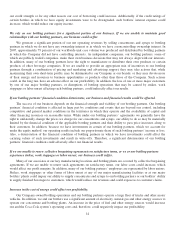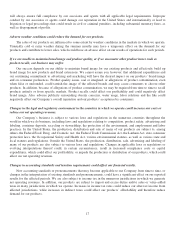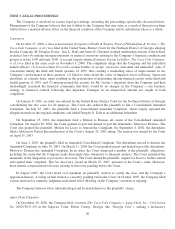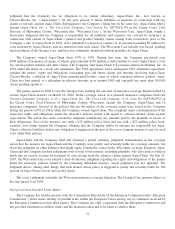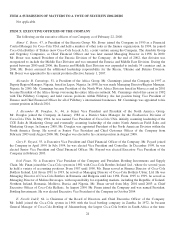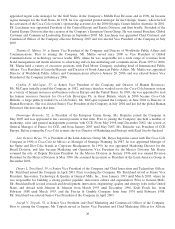Coca Cola 2007 Annual Report Download - page 20
Download and view the complete annual report
Please find page 20 of the 2007 Coca Cola annual report below. You can navigate through the pages in the report by either clicking on the pages listed below, or by using the keyword search tool below to find specific information within the annual report.If we are not able to achieve our overall long-term goals, the value of an investment in our Company could be
negatively affected.
We have established and publicly announced certain long-term growth objectives. These objectives were based on
our evaluation of our growth prospects, which are generally based on volume and sales potential of many product
types, some of which are more profitable than others, and on an assessment of potential level or mix of product sales.
There can be no assurance that we will achieve the required volume or revenue growth or mix of products necessary to
achieve our growth objectives.
If we are unable to protect our information systems against data corruption, cyber-based attacks or network security
breaches, our operations could be disrupted.
We are increasingly dependent on information technology networks and systems, including the Internet, to
process, transmit and store electronic information. In particular, we depend on our information technology
infrastructure for digital marketing activities and electronic communications among our locations around the world and
between Company personnel and our bottlers and other customers and suppliers. Security breaches of this
infrastructure can create system disruptions, shutdowns or unauthorized disclosure of confidential information. If we
are unable to prevent such breaches, our operations could be disrupted, or we may suffer financial damage or loss
because of lost or misappropriated information.
We may be required to recognize additional impairment charges.
We assess our goodwill, trademarks and other intangible assets and our long-lived assets as and when required by
generally accepted accounting principles in the United States to determine whether they are impaired. In 2007, we
recorded net charges of approximately $150 million related to our proportionate share of impairment and restructuring
charges partially offset by our proportionate share of tax rate changes recorded by certain equity investees. Refer to the
heading Equity Income—Net of “Item 7. Management’s Discussion and Analysis of Financial Condition and Results of
Operations” of this report. In 2006, we recorded a charge of approximately $602 million to equity income resulting
from the impact of our proportionate share of an impairment charge recorded by CCE, and impairment charges of
approximately $41 million primarily related to trademarks for beverages sold in the Philippines and Indonesia; and in
2005, we recorded impairment charges of approximately $89 million primarily related to our operations and
investments in the Philippines. If market conditions in certain territories in Europe or Asia in which our Company has
significant investments in bottling operations deteriorate, we may be required to record additional impairment charges.
In addition, unexpected declines in our operating results and structural changes in these and other markets may also
result in impairment charges. Additional impairment charges would reduce our reported earnings for the periods in
which they are recorded.
If we do not successfully manage our Company-owned bottling operations, our results could suffer.
While we primarily manufacture, market and sell concentrates and syrups to our bottling partners, from time to
time we do acquire or take control of bottling operations and have increasingly done so in recent years. As of
December 31, 2007, the net operating revenues generated by Company-owned and controlled bottling operations
(which are included in the Bottling Investments operating segment) represented approximately 26 percent of our
Company’s consolidated net operating revenues. Often, though not always, these acquired bottling operations are in
underperforming markets where we believe we can use our resources and expertise to improve performance.
Acquisitions and consolidation of controlled bottling operations during 2007 have resulted in a substantial increase in
the number of Company-owned bottling plants included in our consolidated financial statements and in the number of
our associates. We may incur unforeseen liabilities and obligations in connection with acquiring, taking control of or
managing bottling operations and may encounter unexpected difficulties and costs in restructuring and integrating them
into our Company’s operating and internal control structures. We may also experience delays in extending our
Company’s internal control over financial reporting to newly acquired bottling operations which may increase the risk
of failure to prevent misstatements in such operations’ financial records. In addition, our financial performance and the
strength and efficiency of the Coca-Cola system depend in part on how well we can manage and improve the
performance of Company-owned or controlled bottling operations. We cannot assure you, however, that we will be
able to achieve our strategic and financial objectives for such bottling operations.
18








